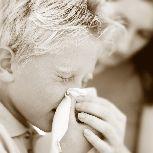食物过敏症“挑食”的孩子伤不起
2014-01-08byEllenLe
by Ellen Le

More children are showing food allergies, including peanuts, but medical investigators dont have a clear explanation for the increase.
Earlier this month a 13-year-old California girl with a peanut allergy died in her fathers arms after unknowingly consuming a small amount of peanut butter in a snack she was eating. The girl quickly spit out the small bit of peanut butter, but efforts to save her life, including multiple injections that should have brought her allergic reaction to a halt, were futile.
The teens death brings to light the dangers faced by those with severe food allergies.
The number of all allergies, including peanuts, is rising, said Dr. Sami Bahna, chief of allergy at Louisiana State University.
The World Health Organization says food allergies appear to be on the rise in all industrialized nations and considers it an important health issue. According to a report in May from the federal Centers for Disease Control and Prevention, the number of U.S. children who have food allergies rose by 50 percent from 1997 to 2011.In particular, peanut allergies among children appear to have tripled between 1997 and 2008, according to a study published in 2010.
There is still no cure for food allergies, although the federal governments investment in food allergy research has risen from $4 million in 2004 to $31 million today, said John Lehr, CEO of Food Allergy Research & Education, a Washington, D.C., nonprofit.
“But more work is needed,” he said.“Scientists do not yet know why there has been an increase in food allergy 1)prevalence.”
Food allergies involve the immune system and can be life-threatening.
Bahna emphasized that true food allergies are much less common than positive skin tests show. For example, peanut allergies affect 1 percent of the population, and of those, only a tenth are severely 2)anaphylactic, capable of causing a sudden, severe and possibly lifethreatening reaction. Ninety percent of peanut reactions are limited to 3)gastrointestinal and 4)dermatological or 5)wheezing symptoms.
Often, allergies are 6)overdiagnosed, which can lead to undue “psycho-social impacts” on the child, Bahna said. Both Lehr and Bahna stressed having a proper diagnosis and detailed management plan from an 7)allergist.
For those who do suffer from life-threatening food allergies, life continues, 8)albeit 9)precariously.
Kylie Kozar, 13, of Los Angeles was diagnosed with a life-threatening peanut allergy when she survived 10)full-blown 11)anaphylaxis at 18 months old after taking a bite of a Tigers Milk protein bar.Her mother, Yael Kozar, was unaware of the severity of peanut allergies at the time.
Kylies blood test showed her level of peanut allergy was “immeasurable,” her mother said. Yael Kozar made the difficult decision to put her television career on hold for her child. “I couldnt trust the world,” she said.
When Kylie was 7, she suffered another 12)traumatizing near-death experience. Her family was eating dinner at one of the five restaurants they trusted. Kylie took a bite of a sauce that the waiter said did not contain peanuts.
“She was on my side of the table in less than a minute, clutching at her throat,” Kozar said. The waiter ran back and found out the sauce did have peanuts. “I knew at that moment I had to inject,” said Kozar, who administered an 13)EpiPen to her daughter. Kylies throat opened up immediately, but the reactions didnt end.
Kylie ultimately suffered four reactions and was in and out of hospitals for three days from one bite. Afterward, she continued to feel like her throat was closing. Doctors investigated and found 14)esophageal 15)scarring, which 16)mimicked anaphylaxis.
Kylie was treated for post-traumatic stress disorder after the incident and still has recurring anxiety. “She thinks its going to happen again,” her mother said.
Until a cure is found, the only way to avoid a reaction is to avoid the 17)allergen. Before she eats anything, Kylie makes sure she knows the ingredients. She also enlists the help of her friends, who tell her when they see someone with a peanut butter and jelly sandwich. Telling friends “you have an allergy and where your meds are is really helpful,” Kylie said.
But how about enlisting the help of your entire school?
Elk Grove schools announced last week that the district would stop serving peanut products in its elementary schools in response to the death last month of 13-year-old Natalie Giorgi.
Bahna believes total peanut bans are impossible to implement, and he worries that they create a false sense of trust in the safety of foods prepared by others. “The schools have been unable to be drug-free or gun-free,” he said.“Schoolchildren with food allergies should eat food prepared by parents at home.”
Last week, the U.S. House of Representatives passed a groundbreaking measure that would expand access to 18)epinephrine auto-injectors in schools, which the president needs to sign, Kozar said.
But Giorgis case is a reminder that emergency treatment can still fail. Giorgis father, a Sacramento doctor, administered three EpiPens before his daughter stopped breathing.“That EpiPens may not always work,” Kozar said, “is truly a new level of torture to the mind.”
After the 19)harrowing experience from that bite of sauce, Kozar presented her daughter with two choices. The first involved being “the bubble child”: home-schooling, no sports and no play dates.
Kylie opted for the second. “ ‘I want to live in the real world and help others. She said that at age 7,” Kozar said. Kylie and her mother have since become national advocates for food allergy awareness.
Melissa Engel, 18, of Illinois has survived a childhood with multiple lifethreatening food allergies, including peanuts. She said that awareness is “definitely already getting better since I was younger—the labeling is getting better.”
But this fall she faces a new challenge: college. In a month, Engel heads to Emory University in Atlanta. She eventually wants to be a 20)pediatrician.
“Next year, Im going to have to be trusting other people to be making my food. But you cant live your life in total fear. Im very careful,” Engel said. “If I have a bad feeling about something, I just dont eat it,”she said.
“Once youre an adult, I think thats easiest because you can make your own food and be in control. Thats whats hardest—is that you cant always be in control having allergies,” Engel said.

越来越多的儿童表现出食物过敏症状,包括对花生过敏,然而医学研究人员并未能对数字攀升的原因作出明确解释。
本月初,一名患有花生过敏症的13岁加州少女在父亲的怀里死去,原因是女孩无意中吃下了含有少量花生酱的零食。女孩立刻吐出吃下的少量花生酱,但是试图挽救其生命的所有努力均未能令她起死回生,包括本应能止住其过敏反应的多次注射也未能起效。
这名少女的离世让人们对严重食物过敏症患者所面临的风险重视起来。
路易斯安那州州立大学过敏科主管萨米·巴纳博士说,过敏症患者的人数,包括花生过敏症患者,正在不断上升。
世界卫生组织称,食物过敏症在所有工业化国家中都呈现上升趋势,是一个值得重视的健康问题。美国联邦疾病预防与控制中心五月份的一份报告显示,从1997年至2011年,美国患有食物过敏症的儿童人数上升了50%。特别值得一提的是,一份2010年发布的研究指出,患有花生过敏症的儿童人数在1997年到2008年之间翻了两番。食物过敏症至今仍无根治方法,虽然联邦政府在食物过敏症的研究经费投入,已经从2004年的400万美元增加至如今的3100万美元,约翰·勒尔如是说。他是华盛顿特区一家食物过敏研究与教育非盈利机构的首席执行官。
“但我们还需投入更多的研究工作,”他说。“科学家们仍然不清楚为何食物过敏症患者会日渐增多。”
食物过敏症关乎免疫系统,可能威胁生命。
巴纳强调,真正的食物过敏症比皮试显示为阳性的过敏症更加少见。比方说,花生过敏症影响着1%的人口,而在这些人口中,只有十分之一的人呈严重过敏症状,这些症状可引致突发的严重反应并可能威胁生命安全。90%的花生过敏症状仅限于肠胃不适以及皮肤过敏、哮喘等症状。
通常,过敏症会被过度诊断,从而给儿童带来过度的“心理社会影响”,巴纳说。勒尔和巴纳均强调,应从过敏症专科医师那里获得合适的诊断及详细的控制方案。
对于那些患有威胁生命的食物过敏症的人来说,生活仍在继续,虽然步步惊心。
13岁的凯莉·科泽来自洛杉矶。18个月大时,她在吃了一口虎奶牌能量棒之后全面过敏,好不容易逃过鬼门关。那时她就被诊断出患有一种威胁生命的花生过敏症。她的母亲耶尔·科泽在那时对花生过敏症的严重性浑然不知。
凯莉的血液测试显示,她的花生过敏症水平“不可估量”,她母亲如是说。耶尔·科泽作出了艰难的抉择,为了孩子,将自己的电视事业暂时搁置。“我无法信任这个世界,”她说。
7岁时,凯莉经历了另一场重创,濒临死亡边缘。她和家人在五家他们信赖的餐厅的其中一家用餐。凯莉吃了一口服务员声称不含花生的酱汁。
“她坐在桌子靠近我的那一边不到一分钟,紧握着喉咙,”科泽说。服务员跑回去,发现酱汁果真含有花生。“那个时候,我知道我需要给她注射,”科泽说,她给女儿注射了肾上腺素。凯莉的喉咙立即打开了,但是过敏反应并未完全消失。
因为这一口,凯莉最终经受了四次过敏反应,三天内几进医院。之后,她继续感觉到喉咙窒闭。医生调查发现她有食道瘢痕,与过敏性反应相类似。
那次事件之后,凯莉接受了创伤后压力紊乱症治疗,至今仍不时出现焦虑。“她总以为这样的事情会再次发生,”她母亲说。
在找出治疗方法之前,避免过敏反应的唯一途径是避免接触过敏原。在进食之前,凯莉需要确保自己清楚知道食物的成分。她也向朋友们寻求帮助,每当朋友们看见有人吃花生酱果冻三明治时就会告诉她。告诉朋友们“自己患有过敏症,随身的抗过敏药物放在哪儿真的很有用”,凯莉说。
但是向全校师生寻求帮助又如何呢?
麋鹿林市的学校在上周发布通告,称鉴于上个月13岁的娜塔莉·吉奥吉的离世,该区将停止在区内小学供应花生食品。
巴纳认为,全面叫停花生供应是不可能实施的,而且他也担心这类花生禁令会营造出一种错觉,让人盲目以为从此他人准备的食物就绝对安全。“学校不可能做到无毒、无枪,”他说。“患有食物过敏症的学童应该吃由家长在家准备好的食物。”
上周,美国众议院通过了一项开创性的措施,措施将拓宽肾上腺自动注射器在学校中的使用限制,这项措施正待美国总统签署颁布,科泽说。
然而,吉奥吉的事件提醒了我们,急救处理也可能无功。吉奥吉的父亲,是一位来自萨克拉门托的医生,在女儿停止呼吸之前,他为她注射了三次肾上腺素。“肾上腺素注射未必总能起效,”科泽说,“这真是一种心灵上更深层次的折磨。”

经历了那一口酱汁的痛苦折磨之后,科泽给出了女儿两个选择。一是当一个碰不得的“泡沫孩子”:在家学习,不参与运动,没有玩伴。
凯莉选择了第二个。“‘我想生活在现实世界里,帮助别人。7岁时的她就这么说,”科泽说。凯莉和她的母亲从此成了唤醒对食物过敏症重视的全国倡导者。
来自伊利诺伊州的18岁的梅丽莎·恩格尔,熬过了一个充满了多种威胁生命的食物过敏症(包括花生过敏症)的童年。她说“从我小时候到现在,对过敏症的重视意识确实提高了不少——食物标签也改善了很多。”
但是,这个秋天,她面临着一个新的挑战:上大学。一个月之后,恩格尔就将前往亚特兰大的埃默里大学读书。她希望将来成为一名儿科医师。
“明年,我就得信赖别人为我准备食物了。不过,你不能总在恐惧中过日子。我非常谨慎,”恩格尔说。“如果我觉得哪些食物感觉不对,我就不会吃,”她说。
“一旦你成年了,我想那就最方便了,因为你可以自己做饭吃。一切可以在掌握之中。最难之处在于——你患有过敏症,你不可能总是运筹帷幄。”恩格尔说。
Top美国十大致敏食品
小 链 接
1. Dairy
2. Eggs
3. Fish
4. Peanuts
5. Tree nuts (walnuts, almonds, cashews, pecans, etc)
6. Sesame
7. Shellfish and other seafood
8. Soy
9. Wheat
10. Gluten (barley, rye, and some other grains)
